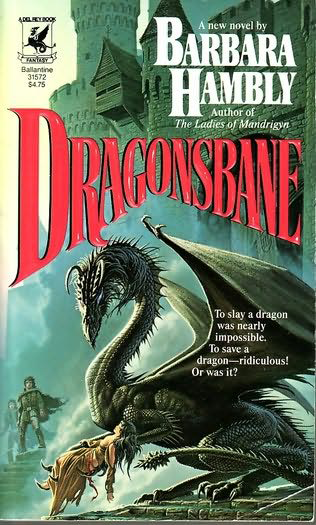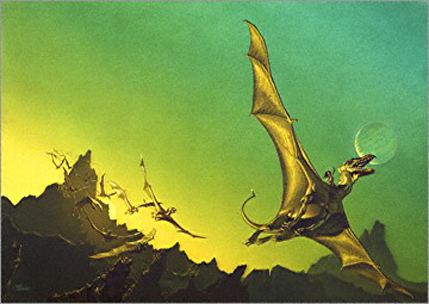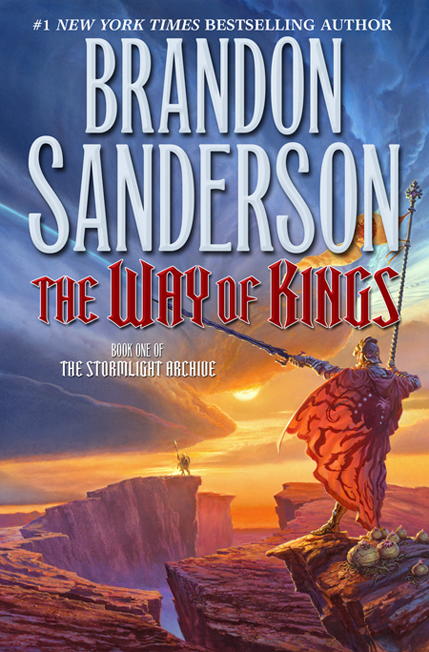They say you can’t judge a book by its cover. I’ve always wondered who “They” are, and if—by chance—they’ve never heard of Michael Whelan. Because my experience in life has been very different.
It’s been almost twenty years now since I first discovered Michael’s work. I was fourteen when it happened, and I was not a reader. I’d been handed a succession of novels about young boys living in the wilderness and taking care of their pet dogs. (Which would die by the end of the book.) I disliked reading with a passion. So, when my eighth-grade teacher assigned me to do a book report, I did everything I could to get out of it.
 That failed. In fact, it failed so solidly that the teacher—unwilling to let me choose my own book to read, for fear I’d choose something not up my reading level—steered me to the back of the room, where she kept a group of ratty paperbacks to loan out to students. You probably know the type—ripped, stained by spaghetti sauce from cafeteria lunches, pages folded and worn. I was told I had to read one of these and had to do a book report on them—and she’d read them all, so she’d know if I tried to fake it.
That failed. In fact, it failed so solidly that the teacher—unwilling to let me choose my own book to read, for fear I’d choose something not up my reading level—steered me to the back of the room, where she kept a group of ratty paperbacks to loan out to students. You probably know the type—ripped, stained by spaghetti sauce from cafeteria lunches, pages folded and worn. I was told I had to read one of these and had to do a book report on them—and she’d read them all, so she’d know if I tried to fake it.
Sullen and annoyed, I began to sift through the books. Most looked terrible. I resigned myself to another dead dog story, but then one of the books actually caught my eye. It had this vivid painting of a dragon standing in the mists, a woman held limply in its hand. Dragonsbane, by Barbara Hambly. The painting was so beautiful, so realistic yet imaginative, that I snatched it up, actually a little eager to look through the pages. I ended up taking it home with me.
I read that book in one day. It wasn’t like anything I’d ever tried reading before. (I had never been introduced to fantasy novels.) Dragonsbane was amazing, challenging, imaginative, gripping, and beautiful all wrapped up in one. I remember a severe bout of disappointment upon finishing the book because I thought surely there couldn’t be anything else like it in the entire world.
 Still, hopeful, I visited the school library the next day. I looked through the card catalog, and picked the next book—alphabetically by title—after Dragonsbane. It was called Dragonflight, by Anne McCaffrey. I went and pulled it out, and was once again captivated by the cover. I took it home and read it.
Still, hopeful, I visited the school library the next day. I looked through the card catalog, and picked the next book—alphabetically by title—after Dragonsbane. It was called Dragonflight, by Anne McCaffrey. I went and pulled it out, and was once again captivated by the cover. I took it home and read it.
My life changed. Now, we throw around sentences like that in writing, using them over and over again until they become as worn as the shoes of a traveling salesman—hardly capable of holding meaning any longer. But let me say it again. My life changed.
I devoured every Anne McCaffrey book in the school library. Suddenly, what I’d discovered in Dragonsbane wasn’t a single, freak event. There was a pattern. If two authors could do this, perhaps there were others. Hungry for more, I went to the bookstore and discovered there was an entire fantasy genre.
 There were so many books. Which to choose? Dragons had treated me well so far, so I looked for some dragon books. And there, right on the shelf, was a beautiful book called Dragon Prince. I consumed it, and then everything else Melanie Rawn was writing.
There were so many books. Which to choose? Dragons had treated me well so far, so I looked for some dragon books. And there, right on the shelf, was a beautiful book called Dragon Prince. I consumed it, and then everything else Melanie Rawn was writing.
What do these books all share? It wasn’t just the dragons; it was the covers. Each time, there was something dramatic and special about them. I now own prints of Dragonsbane and several of Melanie’s covers. All were painted by Michael Whelan.
By the time Tad Williams’ Dragonbone Chair came out, I could recognize Michael’s art on sight. And I also knew to trust it. It didn’t seem logical—you really shouldn’t be able to judge a book by its cover. But a Whelan cover became a seal of approval to me, a sign that the publisher trusted the book so much that they got the best person available to do the cover.
I can’t tell you all of the authors Whelan’s art led me to over the years: Patricia Mckillip, Joan D. Vinge, Stephen Donaldson, and even Asimov. (Yes, you read that right. I first picked up Asimov because Whelan had done the new Foundation covers.)
 I remember when winter 1993 rolled around. My local bookseller noted to me that Whelan had a new art book coming out, one half dedicated to covers, one half dedicated to his fine art. It was the only thing I requested for Christmas, and my parents bought it for me despite the cost. I spent hours leafing through the wonderous, fantastic art. Those imagines sparked things in my mind. I was an author in embryo, absorbing, thinking, dreaming. One of the very first stories I ever wrote was a ‘fanfic’ based on Whelan’s Passage series of fine art prints.
I remember when winter 1993 rolled around. My local bookseller noted to me that Whelan had a new art book coming out, one half dedicated to covers, one half dedicated to his fine art. It was the only thing I requested for Christmas, and my parents bought it for me despite the cost. I spent hours leafing through the wonderous, fantastic art. Those imagines sparked things in my mind. I was an author in embryo, absorbing, thinking, dreaming. One of the very first stories I ever wrote was a ‘fanfic’ based on Whelan’s Passage series of fine art prints.
The years have passed. There are other wonderful fantasy artists out there—and, in a way, the market has finally caught up to Whelan (much as the fantasy genre itself needed time to catch up to Tolkien.) I’ve been lucky to have some of those incredible artists paint covers for my books. But I’ve rarely felt as much excitement, wonder, and awe as I did the when I got to open an email and see the cover for The Way of Kings.
 Irene Gallo (Tor’s art director) asked me to provide a quote about how I feel having a Whelan cover on one of my books. My editor, Moshe, noted “Surely you’ll mention how it’s a dream come true for both you and your editor.” But ‘Dream come true’ is another one of those phrases we use so often it has lost its meaning.
Irene Gallo (Tor’s art director) asked me to provide a quote about how I feel having a Whelan cover on one of my books. My editor, Moshe, noted “Surely you’ll mention how it’s a dream come true for both you and your editor.” But ‘Dream come true’ is another one of those phrases we use so often it has lost its meaning.
How do I really feel? Well, when I was a senior in high school, I was forced to take a life-planning class. In that class, we had to write down ten ‘life goals’ we wanted to achieve some day. #1 on my list, which I still have somewhere, was “Publish a book someday that is good enough to deserve a Michael Whelan cover.”
It has always been a deep-seated desire of mine to one day have a Whelan painting on one of my works. Without this man’s skill and vision, I might never have discovered the fantasy genre, and I might not be writing novels today.
You might say I’m a little bit pleased.

Brandon Sanderson is the author of Elantris, The Mistborn Trilogy, and, with Robert Jordan, the New York Times Bestselling The Gathering Storm, the first of three final volumes to the epic Wheel of Time. The Way of Kings is the first installment in his new epic fantasy series, The Stormlight Archives, and goes on sale in August of 2010.
View more of Michael Whelan’s work on his website.
For a behind the scenes look at the making of The Way of Kings cover, click here.











“I read that book in one day. It wasn’t like anything I’d ever tried reading before. (I had never been introduced to fantasy novels.)… I remember a severe bout of disappointment upon finishing the book because I thought surely there couldn’t be anything else like it in the entire world.”
Oh that hurts it feels so familiar.
I think the first Michael Whelan cover that I really noticed was Dragonfilght in that late 70’s. I was a junior/senior in HS. I remember that it was the sole reason I purchased the book. I was hooked on the series and Michael’s artwork.
Like Brandon, if I see a Whelan cover, I am confident that the book must be good.
Keep up the good work Brandon and congrats on “scoring” a Whelan cover!
Congratulations on getting your first Michael Whelan cover. His art is truely amazing. His work has often led me to picking up some great authors work.
But in my opinion all of your books deserved one of His covers.
thanks to both of you for all you have done and will do.
My favorite Michael Whelan cover is still the double cover for Tad Williams’ To Green Angel Tower. I forget what Williams calls his elves (sihhe or some such), but the way Whelan portrays them, and their weapons, is simply gorgeous, and the contrast with the humans – and their weapons – on the flip side of the cover makes it even better.
The first novel I purchased to where I “judged a book by its cover” was “Dragonbone Chair” (with cover art by Whelan), and that is definitely one of the books that changed my life. I can pretty much eat up anything Tad Williams writes nowadays. That led to the glorious cover (eventually” of “To Green Angel Tower,” which I have a print of in my “mancave.”
Glad to see you got your Whelan cover! Still hoping all the WoT books will be rereleased someday with Whelan art as well!
Ninja’d by a To Green Angel Tower post. Yeah, they were called sithi, and I love also the difference in the not only the characters, but the architecture in the back ground.
Kept trying to think of books I’d bought because the covers were so wonderful…
… but my mind kept going to LP covers I’d bought for the cover. In fact, I not only bought BADGER the LP, but BADGER the CD (when my wife was unable to find a BADGER poster).
The artist: Roger Dean.
And Dean has crafted a host of dragons and wild mindscapes in his time!
http://www.rogerdean.com/
I’d like to thank your teacher for being insistant. And who knows, maybe a kid who is tired of dead dog stories will read Elantris or Mistborn or The Way of Kings and have their world changed too. How cool is that, eh?
Now why on earth can’t we have someone like Whelan (whom I also first picked up the Foundation series in the early 90s based on his awesome new covers) do the remaining WOT covers? DKS obviously doesn’t care anyways.
@9:
Give it up, people have been complaining for 20 years. It is what it is. Go buy the British version.
@brandon:
While Michael Whelan didn’t directly lead me to fantasy (that honor goes to Piers Anthony’s Xanth novels), I totally had the same response to his cover art that you describe. I remember having hte same thoughts about not judging a book by its cover, then coming to the same conclusion you had: you CAN judge a publisher’s OPINION of a book by it’s cover ;)
I heart the Dragon Prince cover. And the McCaffrey ones, but Dragon Prince was the one that really hooked me on Whelan’s work. Just gorgeous. And the depiction of Sioned! I was young, and I was in love.
For me it was Whalen’s Edgar Rice Burrough’s Mars covers that Del Rey did back in the 70s. I still have those beaten up paperbacks.
Ever since then it was always a game to spot his seal in the artwork. My favorite was when he used it as the design on a rug that much have taken up a quarter of the cover.
was there happy dancing?
I hope there was happy dancing.
I know exactly how he feels. I hooked into Whelan’s work initially on the rereleases of The Snow Queen and The Summer Queen, and I now have signed prints of them hanging in my apartment. In Conquest Born is another one of his covers I love – in fact, anything done for C. S. Friedman’s novels. A friend of mine has the original work of the In Conquest Born cover.
The man’s art just makes me shudder with joy.
My first Whelan cover was Dragonflight as well. I fell in love with Pern, and the covers, particularly for The White Dragon, had a lot to do with that.
I know I’m kind of weird but as much as I love Whelan’s art (which I do), I would never have bought a book based on his covers. Partially because so many of those covers had dragons on them, and I just didn’t want to read any books with dragons.
I did, however, pick up The Eye of the World because of the cover. But you know what made me buy it? The complete lack of information about what the book was about. That little text at the back bugged me for weeks until I finally had to buy it just to figure out what the book was about.
That had such a lasting impact on me that these days I never read the inside jacket copy of a book, so I can figure out what the book is by reading it rather than getting a (oft times bad) summary.
Also, a surprising number of great books have truly horrid covers.
THIS! I did this all the time. The first Whelan cover I remember were the Pern novels in the early 80s. In fact when I was in eighth grade I specifically bought Stormbringer because of the cover art by Whelan. In fact I never would have given CS Friedman a chance if it hadn’t been for his fantastic cover art.
As you can probably tell, my favorites are his covers for the Coldfire Trilogy books. He’s my favorite fantasy artist ever.
My own experience is so similar to what most of you have said that I can’t help but feeling connected to you all. :-)
There have been so many wonderful Whelan covers, I would be hard pressed to pick favorites. Like others, I was drawn to those covers, to those books, but it wasn’t until I found out the artist that they all had in common that I realized, “Yep, if it has his art, it’s probably worth a read.”
Stephen R. Donaldson was an early favorite of mine, but I picked up John Carter of Mars and Incarnations of Immortality because of Whelan’s work. I also picked up the Pern books for the same reason, and much later “In Conquest Born.” I agree with The Pendragon that the Coldfire Trilogy covers are fantastic. What a legacy Whelan will leave behind!
And now, Brandon is part of that legacy too. Awesome!
I also follow most of you down the same path of Whelan admiration. Recently met the man & talked with him. While I have a longish list of favorite artists, Whelan remains #1. Myself, I draw a lot and I want my work to resemble his in quality.
I too have bought an awful lot of books based on Whelan covers–although my mother’s copy of DRAGONFLIGHT was the older cover–and one notable book I bought based on a cover that was an intentional parody of a Whelan cover (and a Roger Zelazny blurb). Steven Brust’s TO REIGN IN HELL, which was the first Brust novel I ever encountered.
The man is a gateway drug all by his lonesome.
‘s funny. I have never, ever, EVER bought a book because of its cover. I read book that were recommended to me, first by my parents (thanks, Dad, for giving me The Fellowship of the Rings on my twelfth birthday), then by my friends, then by my friends-on-the-Internet. These days, my reading list comes mainly from this blog.
I appreciate cover art, but I’ll buy a $2 paperback whith an horrid cover sooner than a $3 one whith a beautiful image on it. I don’t even look at them – I just buy the cheapest one on Amazon.
Makes me wonder if I’m missing out…
I’m sorry this is slightly off the topic, but I had to point out something amusing that jumped at me right away: “Dragonflight” should not have been the first title alphabetically *after* “Dragonsbane.” Someone didn’t put the cards back in the right order :)
That was an incredibly touching post.
It’s funny, because I had the same experience but I didn’t know it. I just very recently found out that a large portion of my favourite fantasy novels (DRoP, particularly) were done by Michael Whelan. There’s just something about his art that draws you in to the world.
I am so glad I am not the only person who uses Michael Whelan’s cover art to choose new sci-fi and fantasy books. I absolutely adore his art and have his art as the screensavers on all my computers. It was so surreal to read this description – it is so scarily similar to my own. Congratulations Brian on the cover art! It is deserved!
Brandon,
Your epic novels have probably made me get teary-eyed a number of times. But here, with this little story, you did it all over again, and you didn’t even have to write 700 pages to do it.
Congrats! I’m so excited for The Way of Kings!
It’s funny, Michael Whelan was Artist GOH at a local convention in Denver. My boyfriend and I didn’t even realize he was going to be there until we spoke with two of our artist friends who were in charge of the Art track at the con.
At one point there was a Q&A session with Whelan. He made a comment during that chat session to the effect of “if you’ve ever picked up and read a book because of it’s cover, I did it.” I thought it was a pretty arrogant statement, so the first thing I did when I got home that night was to check out who did the artwork on every “cover” read I did…and discovered he was right. There may have been one or two that I read that he didn’t do the cover, but I don’t think so.
That said, Catspaw, the Otherland series, several Heinlein’s, the Pern books, CS Friedman, and numerous others I can’t think of right now.
And I have to say, the cover for this one looks very interesting.
PS @Anthony Pero – Whelan did the covers for several of the Xanth books, too. Starting with A Spell for Chameleon.
Excellent article. Brandon, you are absolutely worthy of a Whelan cover. Between the multiplification of your fan-base because of your selection to complete the Wheel of Time, the fast-growing recognition for your unique talents as an original fantasy author, and now this totally awesome cover art, The Way of Kings is certainly now among the most hotly anticipated fantasy releases in some time.
Fantasy covers most definitely impact a potential reader’s decision to read a story, and Whelan’s art always offers the expectation of an exciting journey. To use a throw-away phrase of my own, this is a match made in heaven.
Irene’s article with Michael Whelan, describing the process of creating this masterful cover art, is a must read as a parallel to this post by Brandon.
I have the same take on Whelan’s art as Brandon Sanderson. When I see a book cover he’s done, I know it is Michael Whelon’s work and more importantly, it just “feels” like a sure thing – the novel will be good.
It’s similar to some movies – there are a handful of “sure thing” actors and directors. When they’re involved, you know the product will be worthg watching.
@Lachesis
I’ve heard fans echo the sentiment you attributed to Michael Whelan from that panel in Denver, but it sounds really out of character
coming from him.
I’ve always known Michael to be surprisingly humble, especially considering his artistic achievement over 30+ years. In my experience (at conventions and gallery openings), he’s always been reluctant to accept grandiose praise for his work, let alone be the one trumpeting his own influence.
To my point, take a look at the artist commentary on his paintings, which you’ll find both on his website and in his art books). I think most would agree that Michael is his own harshest critic.
With all that being said, I’d like to say thanks to Brandon for sharing his history with Michael Whelan’s work. What he wrote here absolutely resonates with my experience as a reader and a fan.
And thanks to Tor for the pairing of author and artist (both favorites of mine). With Brandon’s exposure on WoT, the timing is just about perfect.
i agree, with everything. i think that you can totally get a feel for the publishers’ opinion for a book by the cover. if it looks cheesy, then it has a good chance to be that way, but if it has a REALLY nice cover then you know that the publishers think that that book (series) will sell and want get people hooked on it.
Brandon Sanderson is one of the best authors i have ever read, and am super excited to read The Way of Kings! Good job landing a Whelan cover, he is magnificent!
Brandon Sanderson scores a Michael Whelan cover.
Yeah, Brandon your talent deserves this. Michael Whelan is my favorite Sci-Fi/Fantasy artist, and Mr. Sanderson you are quickly becoming my favorite Fantasy writer.
Way to go Brandon Sanderson! I met Michael Whelan at a book signing at Forbiddin Planet in New York City YEARS ago and I told him that whenever I couldn’t decide what to read, I’d look for a book with one of his covers. He has never disappointed me. And now, neither has Brandon Sanderson.
Looks like I have to get your books now Brandon :). While I insist on reading at least an excerpt of a book before I buy it, I’ve also learned to trust the ‘Whelan seal of approval(TM)’ — it’s led me to Anne McCaffrey, may she rest in peace, Julian Mayand , C.S Friedman. I’ve also repurchased copies of Burroughs’ Barsoom series when I find copies with Whelan covers. Whelan is one artist I trust to actually *read* the stuff he illustrates for, and usually after reading the book I have to agree that he captured a defining moment or atmosphere from the contents.
It is so strange to read this and see those same covers and read those same titles that were also such a part of my own discovery of the fantasy genre. At the same time, after reading your books it makes perfect sense. I thoroughly enjoy your work! Congrats on getting the Whelan cover!
Agree with this article on so many levels ;)
As a new, young reader, cover art played a large role on the books I chose to pick up and browse. Frank Frazetta was a instant “go to” as was Whelan. My first Whelan book being “The White Dragon”, which I quickly realized was the 3rd book in the series ;)
Along with those, the Neil Adams covers/prints for the Tarzan series were the most influencial to my most impressionalble mind.
I’m grateful for the talent and briliance of such artists that helped lead me to such wonderful and amazing writers!
“Changed my life”
Truer words were never spoken ;)
Warm Regards,
Stu